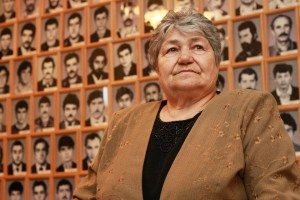Special for the Armenian Weekly

Two remarkable women passed away in June—one in Diyarbakir, the other in Karabagh. One symbolized resilience in the face of continued anti-Armenian policies of Ankara, the other defiance against the policies of Baku. Baydzar Eken and Galya Arustamyan embodied the Armenian struggle for survival on two hostile fronts.
Baydzar greeted us in May, a bright yellow blanket on her knees, her eyes glittering with joy. Armenian faces had started appearing more frequently in her home, located within the walls of the Assyrian Church in Diyarbakir. She remembered how her family—survivors of the Armenian Genocide—had found refuge with an Alevi family in the village of Buyukkadi in Diyarbakir, where she would remain until the age of 23. That was in 1950, a lifetime ago. Something had changed from the days when her family had to live in hiding, and she was happy. “There’s no Armenians here to talk to, so I have forgotten the language,” she confessed, although she continued to switch between Turkish and the Dikranagerd Armenian dialect.
Although she had lived decades of her life as a hidden Armenian, by the time of her death Baydzar’s name graced the headlines in Turkey and the diaspora, as one of the last surviving Armenians of Diyarbakir.
“My father was 14 years old when the massacres happened. They escaped to an Alevi village and that is how they were saved,” she said, as she thumbed her rosary beads. “The Alevis saved them. They hid them, so they didn’t see much. And whatever they saw…they never told us,” she added. Baydzar’s husband, Sarkis, was also saved after hiding at the house of a notable, who Islamized their names on paper—Sarkis became Sidki—but never intervened in their daily life, allowing them to remain Armenian. Sixty years after their wedding at the Sourp Giragos Armenian Church, Baydzar and Sarkis were officially married—by the mayor of Diyarbakir Gultan Kisanak—at the Virgin Mary Assyrian Church in April of this year. “We never had children; that’s why we never pursued official marriage documentation. But this year, I had a concern that if we don’t do it, it means that we’re not together,” said Baydzar.
Although she had lived decades of her life as a hidden Armenian, by the time of her death Baydzar’s name graced the headlines in Turkey and the diaspora, as one of the last surviving Armenians of Diyarbakir.
Two years earlier, and nearly 400 miles away, in Stepanakert, the capital of Karabagh, Galya Arustamyan smiled as she slid a glass of tea towards me. She said it meant the world to her when Diasporan Armenians visited her museum, the Museum of Fallen Soldiers, which she had founded after her son died in the Karabagh War. Outside, the city was buzzing with new construction and preparations for a military parade marking the 20th anniversary of the liberation of Shushi. “I can’t believe that this is our city, because it was destroyed, buildings were in ruins… That was our situation then. There were days that 70 or more people were killed. But we persevered,” she said.

In stark contrast to the festive mood outside, the museum was a somber reminder of the human sacrifices paid to freedom. Her son’s loss weighed heavily on Galya, and the museum became one outlet to ease her pain. It also offered a small degree of relief to others who had lost loved ones. But Galya wanted to do more, to reach out to those who continued to protect the borders. And so once a month she would visit the soldiers on the front lines, bringing them sweets and offering them a motherly ear. “They are our soldiers; we have to encourage them, and look after them,” she told me that May. “We are faced with our old enemies who don’t want us to exist.”
I was struck by the spirit of patience, resilience, and defiance in both women. Baydzar reflected what it meant to remain Armenian against all odds. Galya embodied the sacrifices and hope that became the foundation of a free Artsakh. Neither had it easy, their lives marked by a struggle to defend and retain their identity.
As I wandered through Galya’s museum, the painting of the Virgin Mary cradling the limp body of Christ struck me. In a way, the mural spoke to Galya’s reality. Four words accompanied the painting: “Your bravery is immortal.” And as I reflect on the deaths of Galya and Baydzar, those words echo with new meaning.
Galya Arustamyan passed away on June 16; Baydzar Eken on June 23.


absolutely touching. TKU fo sharing the profile of these heroic Armenian women to us. annie
Amazing women! RIP!
I never had the opportunity to meet Mrs. Arstamyan in person. Indeed, I have never been to Karabagh. However, a friend of mine, who was working in Stepanakert a few years ago and had come to know her, helped me get publications she issued, including the guide to the museum and a commemorative volume of Armenian soldiers who lost their lives during the war. These volumes are now part of the Armenian Research Center collection at the University of Michigan-Dearborn, all three of them signed by Mrs. Arstamyan. May she rest in peace.
She truly persevered ! God Bless Her !
I had the privilege of meeting Galya Arustamyan in 2009 and 2010 when I joined Baroness Caroline Cox’s group to visit Armenia and Artzakh. The museum, which she had established in Stepanakert in remembrance of fallen soldiers, made such an impact on every one of us. In fact, it was a moving experience, and I could hardly hold back my tears. May her family know God’s peace in their sense of loss and may her soul rest in peace.